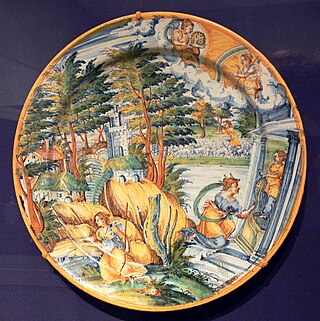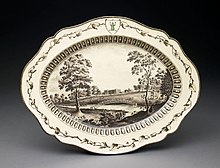
Josiah Wedgwood was an English potter, entrepreneur and abolitionist. Founding the Wedgwood company in 1759, he developed improved pottery bodies by systematic experimentation, and was the leader in the industrialisation of the manufacture of European pottery.

Delftware or Delft pottery, also known as Delft Blue or as delf, is a general term now used for Dutch tin-glazed earthenware, a form of faience. Most of it is blue and white pottery, and the city of Delft in the Netherlands was the major centre of production, but the term covers wares with other colours, and made elsewhere. It is also used for similar pottery, English delftware.

The Catherine Palace is a Rococo palace in Tsarskoye Selo (Pushkin), located 30 kilometres (19 mi) south of St. Petersburg, Russia. It was the summer residence of the Russian tsars. The palace is part of the World Heritage Site Saint Petersburg and Related Groups of Monuments.

Tableware is the dishes or dishware used for setting a table, serving food, and dining. It includes cutlery, glassware, serving dishes, and other items for practical as well as decorative purposes. The quality, nature, variety and number of objects varies according to culture, religion, number of diners, cuisine and occasion. For example, Middle Eastern, Indian or Polynesian food culture and cuisine sometimes limits tableware to serving dishes, using bread or leaves as individual plates, and not infrequently without use of cutlery. Special occasions are usually reflected in higher quality tableware.

Creamware is a cream-coloured refined earthenware with a lead glaze over a pale body, known in France as faïence fine, in the Netherlands as Engels porselein, and in Italy as terraglia inglese. It was created about 1750 by the potters of Staffordshire, England, who refined the materials and techniques of salt-glazed earthenware towards a finer, thinner, whiter body with a brilliant glassy lead glaze, which proved so ideal for domestic ware that it supplanted white salt-glaze wares by about 1780. It was popular until the 1840s.

Biscuit porcelain, bisque porcelain or bisque is unglazed, white porcelain treated as a final product, with a matte appearance and texture to the touch. It has been widely used in European pottery, mainly for sculptural and decorative objects that are not tableware and so do not need a glaze for protection.

Transfer printing is a method of decorating pottery or other materials using an engraved copper or steel plate from which a monochrome print on paper is taken which is then transferred by pressing onto the ceramic piece. Pottery decorated using this technique is known as transferware or transfer ware.

The Rockingham Pottery was a 19th-century manufacturer of porcelain of international repute, supplying fine wares and ornamental pieces to royalty and the aristocracy in Britain and overseas, as well as manufacturing porcelain and earthenware items for ordinary use.

Wedgwood is an English fine china, porcelain and luxury accessories manufacturer that was founded on 1 May 1759 by the potter and entrepreneur Josiah Wedgwood and was first incorporated in 1895 as Josiah Wedgwood and Sons Ltd. It was rapidly successful and was soon one of the largest manufacturers of Staffordshire pottery, "a firm that has done more to spread the knowledge and enhance the reputation of British ceramic art than any other manufacturer", exporting across Europe as far as Russia, and to the Americas. It was especially successful at producing fine earthenware and stoneware that were accepted as equivalent in quality to porcelain but were considerably cheaper.

Mintons was a major company in Staffordshire pottery, "Europe's leading ceramic factory during the Victorian era", an independent business from 1793 to 1968. It was a leader in ceramic design, working in a number of different ceramic bodies, decorative techniques, and "a glorious pot-pourri of styles - Rococo shapes with Oriental motifs, Classical shapes with Medieval designs and Art Nouveau borders were among the many wonderful concoctions". As well as pottery vessels and sculptures, the firm was a leading manufacturer of tiles and other architectural ceramics, producing work for both the Houses of Parliament and United States Capitol.

The Cambrian Pottery was founded in 1764 by William Coles in Swansea, Glamorganshire, Wales. In 1790, John Coles, son of the founder, went into partnership with George Haynes, who introduced new business strategies based on the ideas of Josiah Wedgwood. Lewis Weston Dillwyn became a partner in 1802 and sole owner when George Haynes left the pottery in 1810. In 1811 Dillwyn took T.& J. Bevington into partnership, the company becoming known as Dillwyn & Co.

Victorian majolica properly refers to two types of majolica made in the second half of the 19th century in Europe and America.

Tin-glazed pottery is earthenware covered in lead glaze with added tin oxide which is white, shiny and opaque ; usually this provides a background for brightly painted decoration. It has been important in Islamic and European pottery, but very little used in East Asia. The pottery body is usually made of red or buff-colored earthenware and the white glaze imitated Chinese porcelain. The decoration on tin-glazed pottery is usually applied to the unfired glaze surface by brush with metallic oxides, commonly cobalt oxide, copper oxide, iron oxide, manganese dioxide and antimony oxide. The makers of Italian tin-glazed pottery from the late Renaissance blended oxides to produce detailed and realistic polychrome paintings.

A ceramics museum is a museum wholly or largely devoted to ceramics, usually ceramic art. Its collections may also include glass and enamel, but typically concentrate on pottery, including porcelain. Most national collections are in a more general museum covering all of the arts, or just the decorative arts. However, there are a number of specialized ceramics museums, with some focusing on the ceramics of just one country, region or manufacturer. Others have international collections, which may be centered on ceramics from Europe or East Asia or have a more global emphasis.

Anthony Devis was an English landscape painter, working especially in watercolor and oils and active in London.

The Chesme Church, is a small Russian Orthodox church at 12 Lensoveta Street, in Saint Petersburg, Russia. It was built by the Russian court architect Yury Felten in 1780, at the direction of Catherine the Great, Empress of Russia. A memorial church, it was erected adjacent to the Chesme Palace between Saint Petersburg and Tsarskoye Selo to commemorate the anniversary of Russia's 1770 victory over Turkish forces in Chesme Bay in the Aegean Sea during the Russo-Turkish War of 1768–1774.

Persian pottery or Iranian pottery is the pottery made by the artists of Persia (Iran) and its history goes back to early Neolithic Age. Agriculture gave rise to the baking of clay, and the making of utensils by the people of Iran. Through the centuries, Persian potters have responded to the demands and changes brought by political turmoil by adopting and refining newly introduced forms and blending them into their own culture. This innovative attitude has survived through time and influenced many other cultures around the world.

China painting, or porcelain painting, is the decoration of glazed porcelain objects such as plates, bowls, vases or statues. The body of the object may be hard-paste porcelain, developed in China in the 7th or 8th century, or soft-paste porcelain, developed in 18th-century Europe. The broader term ceramic painting includes painted decoration on lead-glazed earthenware such as creamware or tin-glazed pottery such as maiolica or faience.

Ceramic art is art made from ceramic materials, including clay. It may take varied forms, including artistic pottery, including tableware, tiles, figurines and other sculpture. As one of the plastic arts, ceramic art is a visual art. While some ceramics are considered fine art, such as pottery or sculpture, most are considered to be decorative, industrial or applied art objects. Ceramic art can be created by one person or by a group, in a pottery or a ceramic factory with a group designing and manufacturing the artware.

Leeds Pottery, also known as Hartley Greens & Co., is a pottery manufacturer founded around 1756 in Hunslet, just south of Leeds, England. It is best known for its creamware, which is often called Leedsware; it was the "most important rival" in this highly popular ware of Wedgwood, who had invented the improved version used from the 1760s on. Many pieces include openwork, made either by piercing solid parts, or "basketwork", weaving thin strips of clay together. Several other types of ware were produced, mostly earthenware but with some stoneware.
![The green frog carried on every piece. According to Josiah Wedgwood's Victorian biographer "he was very unwilling to disfigure the service with this reptile [sic], but was told it was not to be dispensed with". Wedgwood. Serviz s zelionoi liagushkoi (13).JPG](http://upload.wikimedia.org/wikipedia/commons/thumb/e/e3/Wedgwood._%D0%A1%D0%B5%D1%80%D0%B2%D0%B8%D0%B7_%D1%81_%D0%B7%D0%B5%D0%BB%D1%91%D0%BD%D0%BE%D0%B9_%D0%BB%D1%8F%D0%B3%D1%83%D1%88%D0%BA%D0%BE%D0%B9_%2813%29.JPG/220px-Wedgwood._%D0%A1%D0%B5%D1%80%D0%B2%D0%B8%D0%B7_%D1%81_%D0%B7%D0%B5%D0%BB%D1%91%D0%BD%D0%BE%D0%B9_%D0%BB%D1%8F%D0%B3%D1%83%D1%88%D0%BA%D0%BE%D0%B9_%2813%29.JPG)





























